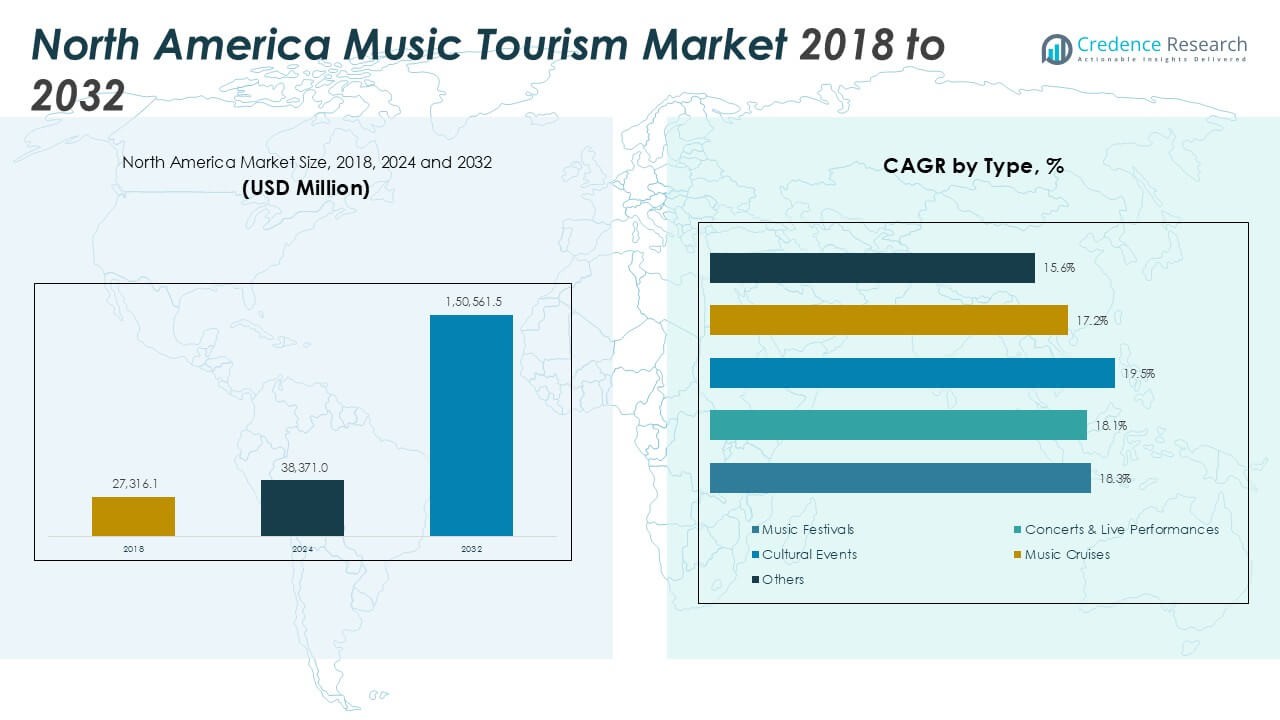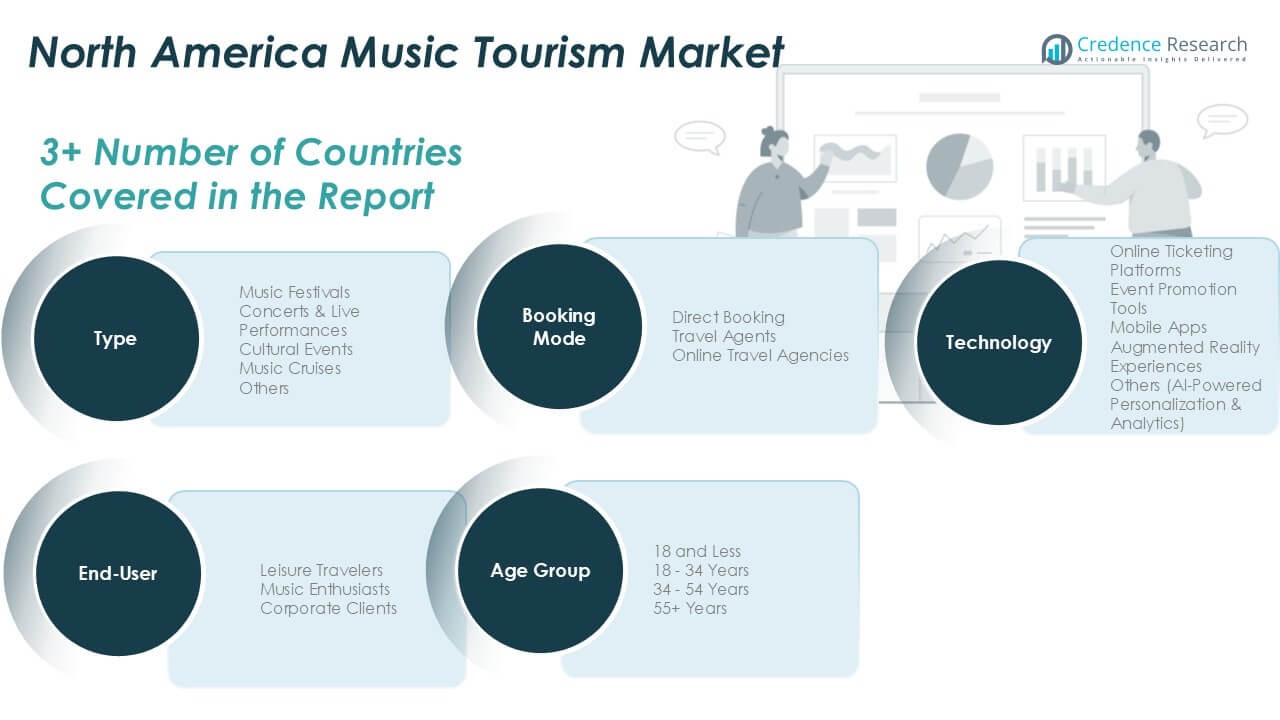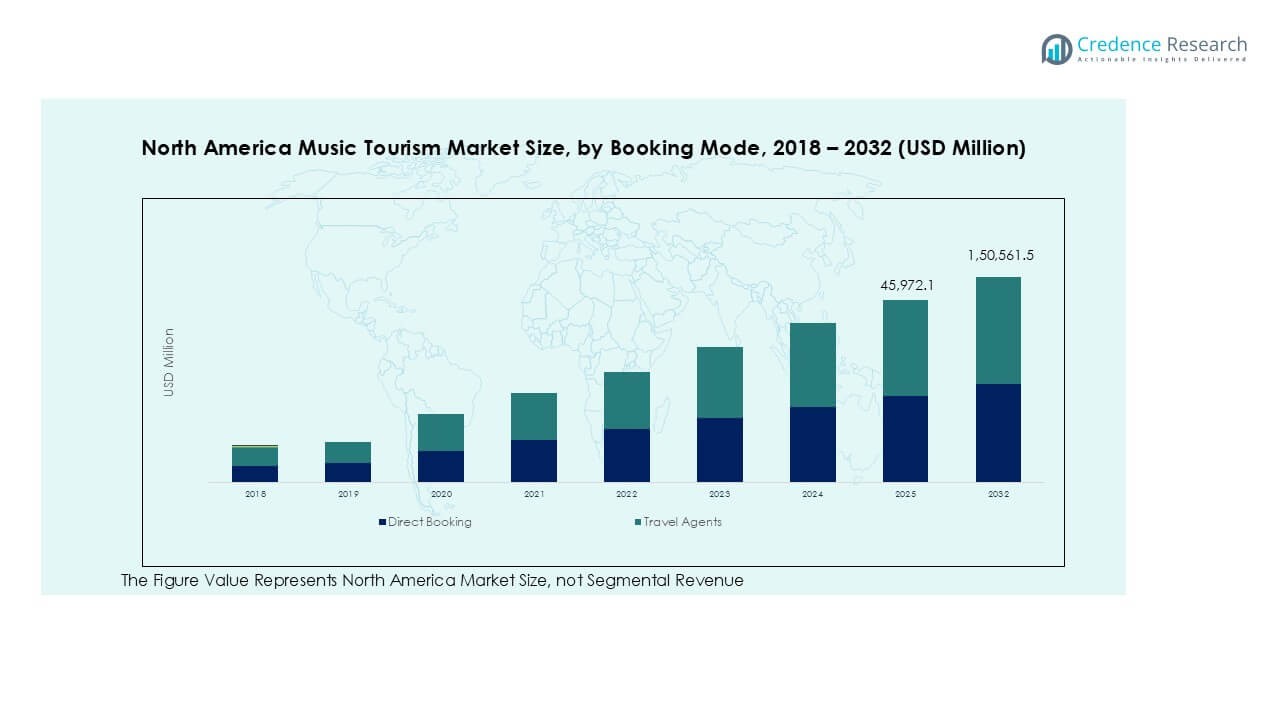Market Overview
North America Music Tourism market size was valued at USD 27,316.12 million in 2018, increasing to USD 38,371.01 million in 2024, and is anticipated to reach USD 150,561.54 million by 2032, growing at a CAGR of 18.47% during the forecast period.
| REPORT ATTRIBUTE |
DETAILS |
| Historical Period |
2020-2023 |
| Base Year |
2024 |
| Forecast Period |
2025-2032 |
| North America Music Tourism Market Size 2024 |
USD 38,371.01 Million |
| North America Music Tourism Market, CAGR |
18.47% |
| North America Music Tourism Market Size 2032 |
USD 150,561.54 Million |
The North America music tourism market is led by major companies such as Live Nation Entertainment, AEG Presents, C3 Presents, Insomniac Events, and Another Planet Entertainment. These firms dominate the live event and festival landscape through extensive artist networks, multi-city event operations, and strong partnerships with ticketing platforms like Ticketmaster and Eventbrite. Supporting players such as StubHub, Vivid Seats, and Festicket enhance market accessibility through innovative digital booking systems. The United States remains the leading region, commanding 71% of the total market share in 2024, followed by Canada with 21% and Mexico with 8%, reflecting strong regional diversification and cross-border event participation.
Access crucial information at unmatched prices!
Request your sample report today & start making informed decisions powered by Credence Research Inc.!
Download Sample
Market Insights
- The North America music tourism market was valued at USD 38,371.01 million in 2024 and is projected to reach USD 150,561.54 million by 2032, growing at a CAGR of 18.47%.
- Growing popularity of large-scale music festivals and live performances drives travel demand across major cities and cultural destinations.
- Trends such as hybrid festival formats, digital ticketing, and immersive concert experiences are reshaping audience engagement and boosting regional participation.
- The market is highly competitive, with leading players like Live Nation Entertainment, AEG Presents, C3 Presents, and Ticketmaster dominating through large event portfolios and cross-industry collaborations.
- The United States held a 71% regional share in 2024, followed by Canada with 21% and Mexico with 8%, while the music festivals segment led by type with 46% share, supported by high attendance and strong spending from the 18–34-year age group.
Market Segmentation Analysis:
By Type
The music festivals segment dominated the North America music tourism market in 2024 with a 46% share. Large-scale events such as Coachella, Lollapalooza, and Bonnaroo attract millions of domestic and international visitors each year. These festivals drive significant spending on travel, accommodation, and local experiences, fueling regional tourism economies. The growing preference for multi-day events and diverse genre representation enhances participation across age groups. Increasing investments in event infrastructure, sponsorships, and hybrid festival formats are strengthening the segment’s dominance and positioning North America as a global music tourism hub.
- For instance, Coachella 2024, produced by Goldenvoice (a subsidiary of AEG Presents), took place over two weekends in April at the Empire Polo Club in Indio, California. The official lineup featured 147 musical acts, including headliners Lana Del Rey, Tyler, the Creator, and Doja Cat.
By Age Group
The 18–34 years age group led the market with a 54% share in 2024, reflecting the strong travel intent and higher spending power of young adults. This demographic actively seeks immersive live experiences, social engagement, and music-driven travel opportunities. The rise of social media influence and digital ticketing platforms further supports participation in festivals and concerts. Younger audiences prioritize experiential travel, often combining music events with leisure and adventure tourism. The segment’s growth is also driven by rising disposable incomes and increased awareness of international music festivals and emerging artists.
- For instance, in 2024, Eventbrite served as a major marketplace for event ticketing, distributing 270 million total tickets globally for more than 4.7 million events. Demographic insights from the US music tourism market indicate that young adults (aged 18–34) are a dominant consumer group for live events.
By End-User
Leisure travelers accounted for the largest share of 49% in the North America music tourism market in 2024. This group includes casual tourists who integrate concerts and music festivals into broader vacation plans. Rising demand for destination-based entertainment, coupled with the expansion of hospitality and travel packages tailored to music events, supports the segment’s growth. Partnerships between event organizers and travel agencies are enhancing accessibility and affordability. Additionally, the increasing popularity of themed tourism—such as heritage music routes and festival-based vacations—continues to attract leisure travelers across diverse age groups.

Key Growth Drivers
Expanding Festival Ecosystem and International Artist Lineups
A key growth driver in the North America music tourism market is the rapid expansion of large-scale festivals that attract both domestic and international audiences. Events such as Coachella, Lollapalooza, and Austin City Limits have become global cultural icons, drawing millions of visitors annually. The inclusion of diverse international artists enhances audience appeal and supports cross-border tourism. Investments in venue capacity, sustainability measures, and digital ticketing platforms improve accessibility and visitor experience. Local governments also support these festivals through tourism promotion, transport infrastructure, and event licensing, making them central to regional economic growth.
- For instance, Lollapalooza 2024 hosted over 400,000 attendees in Chicago’s Grant Park across four days, featuring more than 170 artists. Meanwhile, AEG’s subsidiary Goldenvoice, which operates Coachella, expanded its sustainability initiatives in 2024 by replacing traditional diesel generators with modular battery systems powered by solar and the electrical grid.
Rising Integration of Travel and Entertainment Experiences
The increasing convergence of travel and entertainment experiences strongly fuels market growth. Tourists now seek experiential journeys where music events, leisure, and cultural exploration intersect. Major cities such as Las Vegas, Nashville, and Los Angeles have become year-round hubs for live performances, combining concerts with nightlife, food, and heritage tourism. Travel agencies and online booking platforms are introducing festival packages, offering curated itineraries for music-focused vacations. This trend enhances visitor spending across hospitality, retail, and local attractions while reinforcing the role of music tourism in diversified destination marketing strategies.
- For instance, Expedia Group launched a Travel Hub in 2024 to promote the New Orleans Jazz & Heritage Festival, creating a centralized location for music fans to book their travel and find exclusive deals.
Technological Advancements in Event Access and Engagement
Technology innovation drives strong market momentum across North America. Mobile ticketing, AI-based event recommendations, and virtual participation options have transformed how fans experience live performances. Platforms integrating augmented and virtual reality offer immersive concert experiences for remote audiences, extending reach beyond physical venues. Social media platforms amplify event visibility, promoting early engagement and fan-driven marketing. Moreover, digital data analytics help organizers optimize crowd management, enhance personalization, and improve safety measures. The technological ecosystem around music events supports efficiency, engagement, and inclusivity, fostering sustained market expansion.
Key Trends & Opportunities
Growth of Hybrid and Niche Music Experiences
A key trend shaping the market is the rise of hybrid events and niche music tourism. Organizers now combine live performances with virtual streaming to broaden audience access and revenue streams. Additionally, specialized experiences such as jazz retreats, folk heritage routes, and eco-conscious outdoor festivals cater to targeted demographics. These offerings appeal to travelers seeking personalized and culturally immersive journeys. The diversification of music tourism formats across urban and rural destinations enhances inclusivity while reducing reliance on large-scale festivals for market growth.
- For instance, the Telluride Bluegrass Festival, hosted by Planet Bluegrass, is widely recognized for its sustainability initiatives. Its “Sustainable Festivation” program includes efforts like voluntarily offsetting its carbon footprint and earning a Greener Festival Improvers Certification in 2024.
Cross-Sector Partnerships and Tourism Innovation
The increasing collaboration between music promoters, travel companies, and government tourism boards presents new opportunities for market expansion. Partnerships focus on destination branding, sustainability, and long-term festival tourism development. Airlines, hotels, and local transport providers are aligning with event organizers to offer seamless travel solutions. Additionally, regional authorities are leveraging music tourism to boost off-season visitor traffic and support small businesses. This synergy between entertainment and tourism sectors strengthens North America’s position as a leading global music destination.

Key Challenges
Regulatory and Infrastructure Constraints
Despite strong growth, the market faces challenges from complex regulations and limited infrastructure in certain regions. Large festivals often require extensive permits, zoning clearances, and safety compliance, leading to administrative delays and high operational costs. Insufficient transport networks or accommodation facilities near major event venues can also limit visitor capacity. Smaller towns hosting cultural or niche music events struggle to manage large tourist inflows, impacting the overall experience. Addressing these infrastructure gaps and simplifying event regulations remain vital to sustaining long-term market growth.
Environmental and Sustainability Pressures
Environmental concerns represent another major challenge for the North America music tourism market. High energy consumption, waste generation, and carbon emissions from large festivals create sustainability issues. Increasing public scrutiny and stricter environmental norms compel organizers to adopt eco-friendly practices such as renewable energy use, waste recycling, and digital ticketing. However, implementing these measures often raises event costs, impacting profitability for smaller organizers. Balancing economic benefits with sustainability goals will be critical to maintaining the market’s credibility and long-term viability.
Regional Analysis
United States
The United States dominated the North America music tourism market in 2024 with a 71% share. The country’s extensive network of music festivals, concerts, and iconic venues attracts millions of visitors annually. Major events like Coachella, Lollapalooza, and Austin City Limits fuel significant domestic and international travel. Cities such as Nashville, Los Angeles, and New York serve as cultural anchors, offering diverse genres from country and rock to jazz and pop. Strong investments in event infrastructure, marketing campaigns, and tourism partnerships continue to strengthen the U.S. position as the leading hub for global music tourism.
Canada
Canada accounted for a 21% share of the North America music tourism market in 2024. The country benefits from growing interest in festivals such as Osheaga, Calgary Folk Music Festival, and Montreal International Jazz Festival. Government-backed cultural tourism initiatives and improved cross-border travel options support visitor growth. Cities like Toronto, Montreal, and Vancouver are emerging as vibrant centers for both mainstream and niche music events. Rising demand for regional and indigenous music experiences further diversifies Canada’s offering, reinforcing its role as a strong contributor to the regional music tourism landscape.
Mexico
Mexico held an 8% share of the North America music tourism market in 2024, driven by its rich cultural heritage and expanding festival scene. Events such as Vive Latino and Corona Capital attract growing international audiences, boosting local tourism revenue. The country’s blend of traditional and contemporary music, supported by scenic venues and hospitality infrastructure, enhances its appeal. Investments in regional event promotion and partnerships with travel operators encourage cross-border tourism from the United States and Canada. Mexico’s increasing recognition as a year-round music tourism destination continues to strengthen its share within the regional market.

Market Segmentations:
By Type
- Music Festivals
- Concerts & Live Performances
- Cultural Events
- Music Cruises
- Others
By Age Group
- 18 and Less
- 18–34 Years
- 34–54 Years
- 55+ Years
By End-User
- Leisure Travelers
- Music Enthusiasts
- Corporate Clients
By Technology
- Online Ticketing Platforms
- Event Promotion Tools
- Mobile Apps
- Augmented Reality Experiences
- Others (AI-Powered Personalization & Analytics)
By Booking Mode
- Direct Booking
- Travel Agents
- Online Travel Agencies
By Geography
- United States
- Canada
- Mexico
Competitive Landscape
The North America music tourism market features a competitive mix of event organizers, ticketing platforms, and travel service providers. Leading companies such as Live Nation Entertainment, AEG Presents, and C3 Presents dominate through extensive event portfolios, international artist partnerships, and large-scale festival operations. Firms like Insomniac Events and Another Planet Entertainment focus on niche segments such as electronic dance and alternative genres, enhancing market diversity. Ticketing platforms including Ticketmaster, Eventbrite, and StubHub strengthen accessibility through advanced digital sales and mobile engagement tools. Strategic collaborations between promoters, tourism boards, and hospitality partners further enhance audience reach and experience quality. Moreover, the increasing adoption of hybrid and sustainability-focused events enables established players to maintain leadership while supporting long-term market growth.
Shape Your Report to Specific Countries or Regions & Enjoy 30% Off!
Key Player Analysis
Recent Developments
- In February 2025, Busan Concert Hall launched its official website to provide classical music enthusiasts with a seamless platform for ticket reservations, venue rentals, and academy schedules. Designed with responsive technology, the site ensures accessibility across devices and features a mobile ticketing service for quick entry via barcode scanning. The initiative enhances convenience and enriches the cultural experience for visitors in Busan.
- In August 2024, Brightline launched “The Big Concert Sweepstakes,” offering tickets to Taylor Swift’s sold-out Miami concert on October 20. The prize included two concert tickets, four round-trip Brightline tickets on a special “Tay-keover Sing-Along” train, and exclusive lounge perks. Participants entered by following Brightline on Instagram and signing a rail safety pledge, with the winner announced during Rail Safety Week in late September.
- In May 2024, Live Nation brought back its annual Concert Week promotion, offering USD 25 all-in tickets for over 5,000 shows across North America. Featuring artists like Janet Jackson and 21 Savage, the week-long event made live music more accessible to fans. Tickets, available from May 8 to May 14, could be purchased online without a promo code, allowing fans to enjoy significant savings on select concerts and festivals. The initiative aimed to enhance the summer touring season with budget-friendly options.
Report Coverage
The research report offers an in-depth analysis based on Type, Age Group, End-User, Technology, Booking Mode and Geography. It details leading market players, providing an overview of their business, product offerings, investments, revenue streams, and key applications. Additionally, the report includes insights into the competitive environment, SWOT analysis, current market trends, as well as the primary drivers and constraints. Furthermore, it discusses various factors that have driven market expansion in recent years. The report also explores market dynamics, regulatory scenarios, and technological advancements that are shaping the industry. It assesses the impact of external factors and global economic changes on market growth. Lastly, it provides strategic recommendations for new entrants and established companies to navigate the complexities of the market.
Future Outlook
- Expansion of large-scale music festivals will continue to attract international tourists.
- Integration of virtual and hybrid concert formats will broaden audience reach.
- Growing partnerships between event organizers and tourism boards will boost cross-border travel.
- Rising demand for eco-friendly and sustainable music events will shape future operations.
- Increased adoption of digital ticketing and cashless payment systems will enhance convenience.
- Emerging cities will invest in music tourism infrastructure to diversify local economies.
- Personalized travel packages combining music, culture, and leisure will gain popularity.
- Government initiatives supporting cultural tourism will strengthen regional market growth.
- Advanced data analytics and AI tools will improve event planning and audience engagement.
- Expanding participation from younger demographics will sustain long-term demand for live music tourism.









